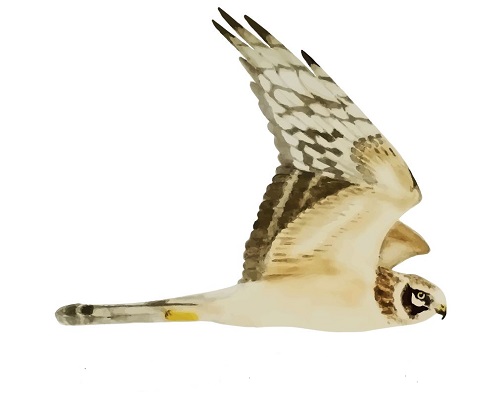Her på Skagen Fuglestations blog bringes korte nyheder i dagbogsformat om hændelser på fuglestationen.
Se indlæg fra måned: jan. (1)feb. (8)mar. (31)apr. (29)maj (30)juni (28)juli (32)aug. (31)sept. (30)okt. (31)nov. (30)dec. (8)
Back to work
After all those days with very adverse weather, we almost forgot, what it is like to work at Skagen Fuglestation: normally you are always busy and even when you are not you still have to decide whether you want to go out birding or catch up on sleep. Now, finally we’re getting into the daily rhythm again (of working night and day)!
Simon junior and Bjørn got up early this morning, along with Johanna, who has been a volunteer earlier this year and is now back on holidays with her family. In dire need of the “real Skagen experience” she asked if she could join us this morning, which we highly appreciated. I “slept in” until 5.30 and joined them, Knud, and Henrik a little later at World’s End 3, by which time I had already missed several hundreds of fulmars (mallemuk), a manx shearwater (almindelig skråpe) and three arctic skuas (almindelig kjove). So it seems that the day has been better than the last few days. Actually, the skuas had arrived on the beach last night. I got a nice picture of one of them through the scope, taken with the phone (so not as good as Simon’s pictures).
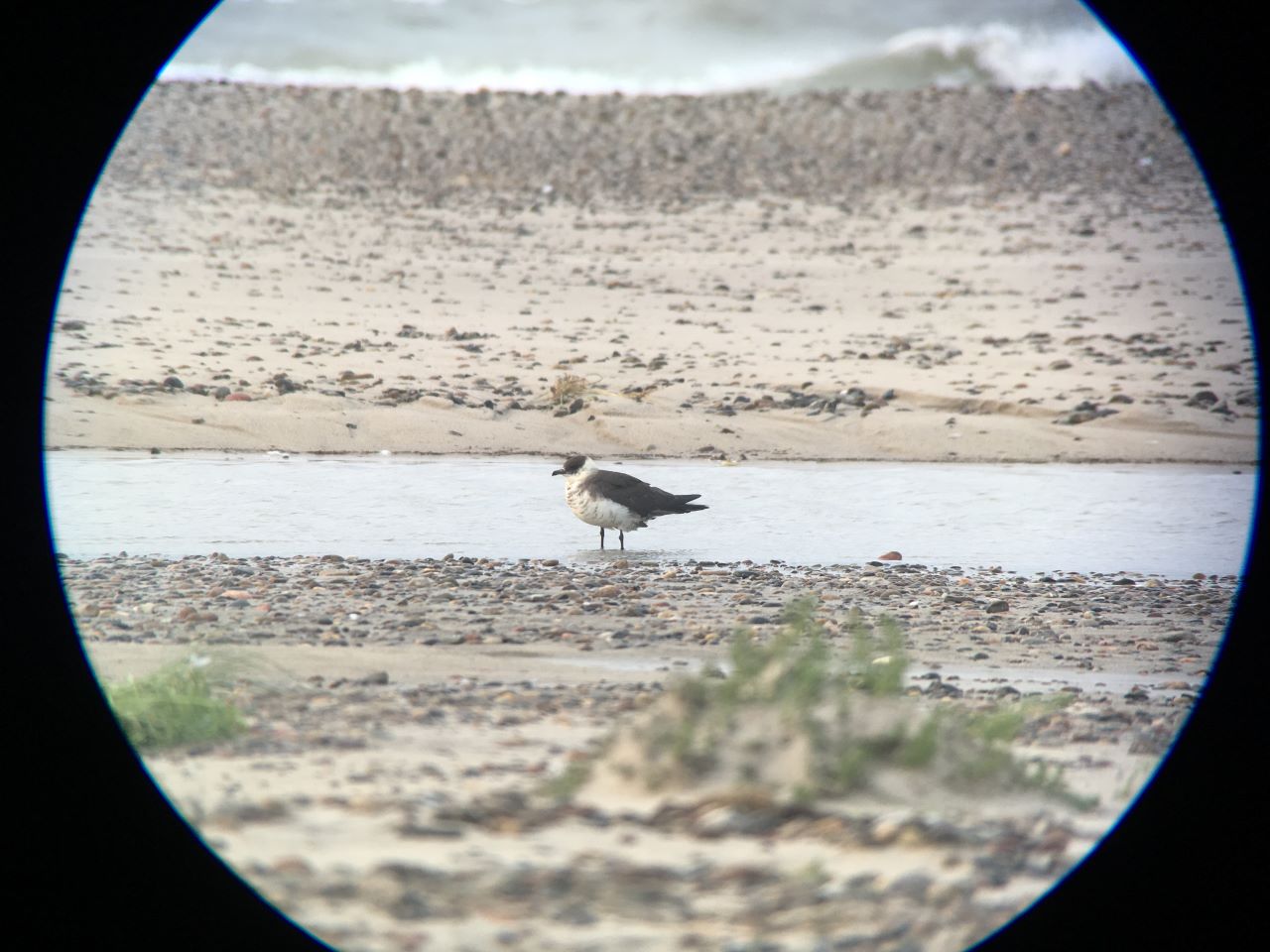
And here is how the morning looked, sunny and less windy, so actually a really nice morning out.
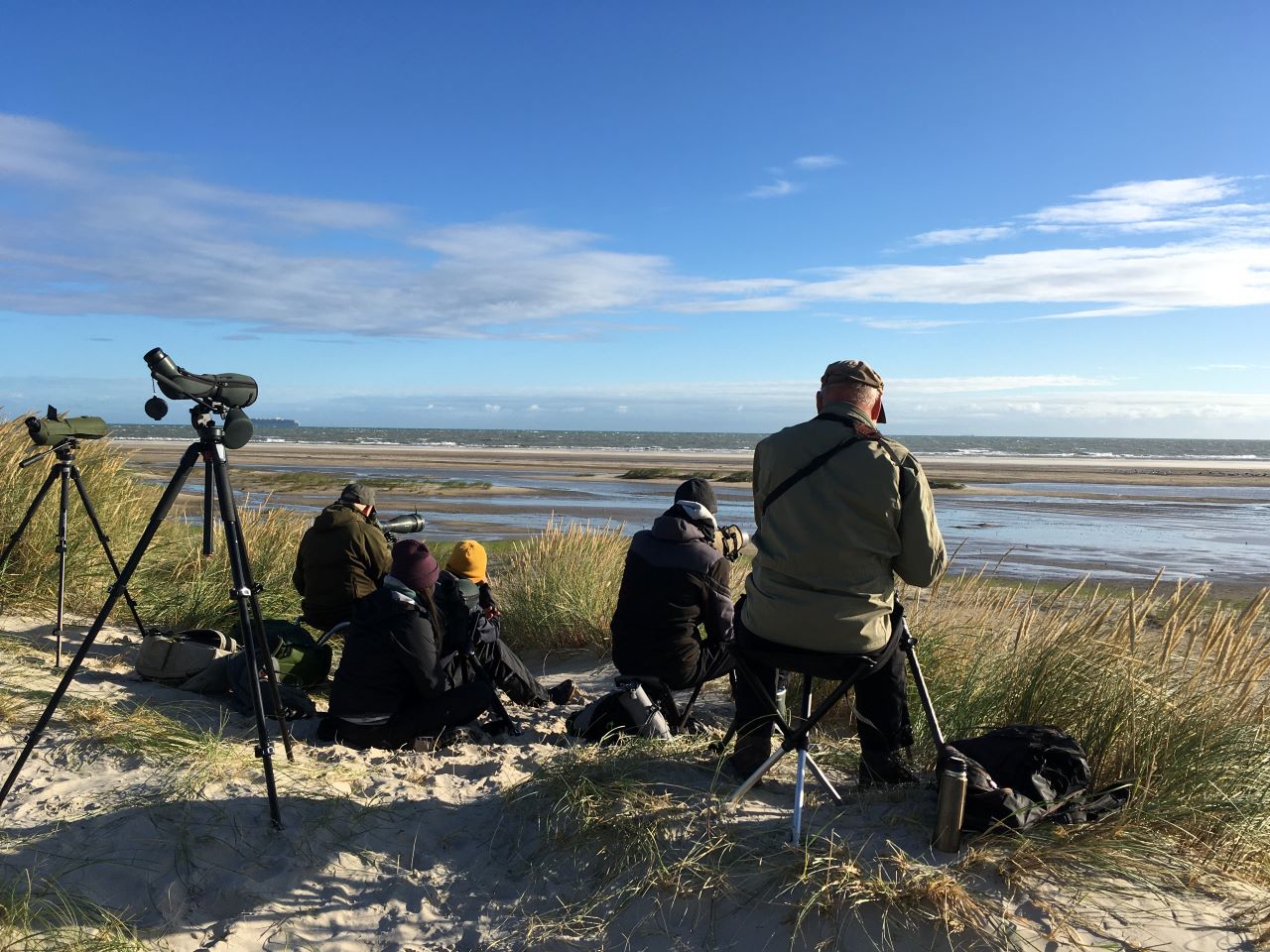
Unfortunately, the wind was still too strong for opening nets, but there were also some nice shorebirds to look at, on the beach, so I could have some fun too.
In the afternoon, Peter Kristensen came out again, to set up the new radio telemetry equipment with which we are hoping to record passing birds with telemetry tags on them. All of us helped together to build a setup for the solar panel and a fence to keep the cows away from our equipment.
Also, yesterday, as there were so many kittiwakes (ride) roosting on the beach, Knud and Simon managed to read quite a few rings. We reported them today, and, amazingly, already received an immediate answer from Kjeld Pedersen: some of them were ringed in 2015 and have not been reported since! The oldest was ringed in 2014, so is now 9 years old!
After the evening meeting, Bjørn finally showed off his amazing cooking skills (Sean, we found a replacement for you! Downside is, he’s only staying for 2 weeks). Now we try to get some sleep before we get up again at sunset (little vampire-like feeling) to set up the nets for the night catching Simon junior has been wishing for for days now. Johanna will come back to help us with that, so we can get some sleep before our next tasks in the morning.
It will also be Bjørn’s first “ringing” session, before he get’s to join me at the ringing at Kabeltromlen tomorrow morning. Due to the southerly winds, however, there will probably not be many birds, but that gives Bjørn the chance to slowly learn extracting the birds and recording all the measurements we take at the ringing.
There may be night catching again tomorrow night, if you are interested in coming, we will keep you updated on Facebook and Zello.
People: Peter Kristensen, Martina Hillbrand, Simon Kiesé, Bjørn Laursen, Simon S. Christiansen, Lisa Vergin, Karen and Henrik Toft
A link to today's observations from volunteers and local observers.
After the storm
As my first full day on the station, Martina, Simon junior and I went out to do the migration count with high hopes after the storm, although there was still a lot of wind. We were met on the beach with over 100 roosting Kittiwakes (Ride). Knud was out there when we got to World’s End 3 and the guests joined us later. Martina went to Nordstrand to see if there were more kittiwakes (ride) there, but found instead various shorebirds. During the migration count we saw species such as arctic skua (almindelig skråpe), fulmars (mallemuk), razorbills (alk), etc. Martina rejoined with us after a while, but later her and I then went back to Nordstrand. Just before Knud and Simon were about to leave, they saw a manx shearwater (almindelig skråpe) migrating and Simon had talked about he was hoping for it the day before.
When we had gotten back and rested after lunch, I went out with the guests to Jerup Strand. We saw 12 spoonbills (skestork), which we enjoyed looking at in quite close range. As well as a mixture of shorebirds such as red knot (islandsk ryle) and bar-tailed godwit (lille kobbersneppe).
 Spoonbills (skestork) foraging. Foto: Henrik Toft
Spoonbills (skestork) foraging. Foto: Henrik Toft
Just as I arrived home, I found Martina in the proces of ringing a common house martin (bysvale) as it had flown into the lighthouse store and she had to rescue it. I spent the evening helping her with trimming the trees and bushes around the nets used when ringing and we made it home in time for when the guests had cooked us dinner.
I am looking forward to the next two weeks I will spend here and hope to learn from a lot from the more experienced birders. I also hope the weather will soon allow for some ringing.
Ringing (Det Grå Fyr):
Bysvale (House martin) - 1
total: 1
People: Martina Hillbrand, Simon Kiesé, Bjørn Laursen, Simon S. Christiansen, Lisa Vergin, Karen and Henrik Toft
Get to know the people at the station.
A link to today's observations from volunteers and local observers.
Windy day
As luck would have it, I have the honour of writing this blog on this rather boring day. But it wasn't completely boring, as was already evident in the morning.
We didn't mind wind force 8, so Martina and I set off for Grenen at 5 am. Visibility was too bad for the migration count, but due to the storm the beach is now flooded and some Waders (Ryle) and even more Kittiwakes (Ride) than yesterday are sitting there. Birds already spotted in previous days, such as Red Knot (Islandsk Ryle), Little Sandpipers (Dværgryle) and Temminck's Stint (Temmincksryle) showed up again and it was fun to watch them running around. My hope that the visibility would clear up again for some seawatching was dashed when it started to rain. At least I was delighted to see two resting Black Terns (Sortterne) moulting from breeding plumage into summer plumage. It rained and didn't stop. Luckily I had taken the overall with me, which withstood even this weather.
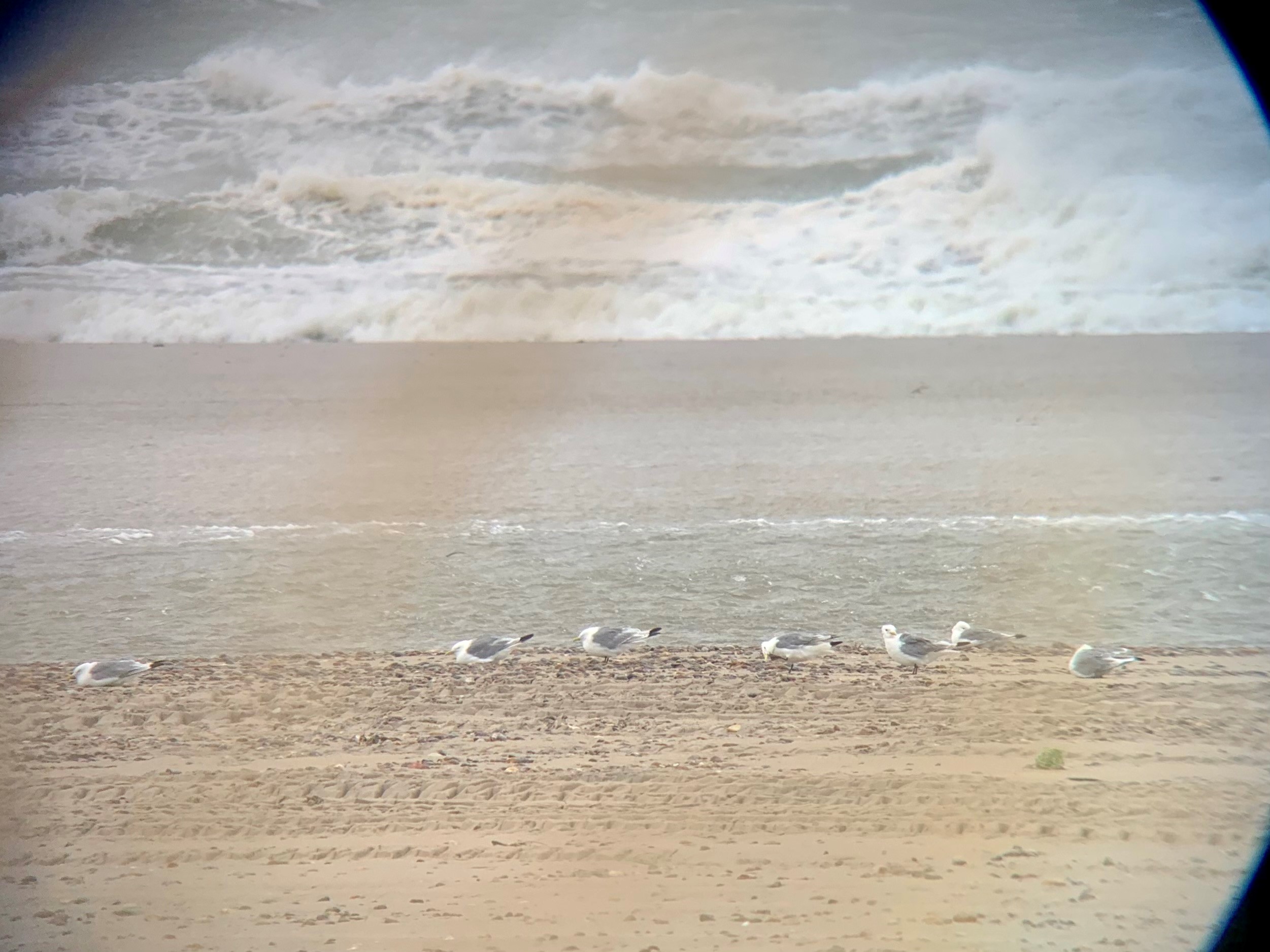 roosting Kittiwakes (Ride) at the beach
roosting Kittiwakes (Ride) at the beach
Back home we entered the data and took a break. We checked the weather forecast every minute to see when the rain would finally stop. The rain break was also nice to watch an episode of the new series 'Good Omes 2' with a hot chocolate. Just normal human stuff.
When the rain stopped in the early afternoon, I went straight to World's End 3. Hoping for shearwaters, I was happy about the now quite good visibility. But hours passed and nothing came. Well, that's life as a birder. The time was nevertheless entertaining, as some Common Scoters (Sortand) and a few Velvet Scoters (Fløjlsand) passed through. I also saw three Fulmars (Mallemuk) and another Black Tern (Sortterne). Among the waders we had already looked through this morning, there were now also two pretty Curlew Sandpipers (Krumnæbbet Ryle) and a Bar-tailed Godwit (Lille Kobbersneppe). The guests in the apartment used the bad weather to go to town into the art museum.
Meanwhile, Martina went shopping in town and Simon (the first) picked up the new volunteer Bjørn from the station. He is Danish and has only been birdwatching this year. So he is looking forward to the impressions and experiences he will gain during his stay here for the next two weeks.
People: Martina Hillbrand, Simon Kiesé, Bjørn Laursen, Simon S. Christiansen, Lisa Vergin, Karen and Henrik Toft
A link to today's observations from volunteers and local observers.
Wind and Rain
What can I say? It is a bit too windy to open the nets and with the rain, seawatch is not so easy. We still went out this morning and afternoon and did see some birds. Actually, Grenen beach is quite nice, because it is flooded again, and the number of shorebird species is increasing. Only, we don’t have pictures because with the rain you try to not take out electronic equipment, if not necessary.
This morning on the beach there were several dunlins and sanderlings (almindelig ryle og sandløber), as there used to be, but in addition to that: 2 red knots (islandsk ryle), 1 ruff (brushane), 3 curlew sandpipers (krumnæbbet ryle) and a couple oystercatchers (strandskade), next to the ever present ringed plovers (stor præstekrave). In the afternoon, Simon junior went there again and saw that one of the red knots has a ring. We ringed a couple last year, so maybe it is ours. Maybe tomorrow we can get a picture and try to read the ring…
Also, in the afternoon, Simon saw a temminck’s stint (temmincksryle), a little stint (dværgryle), and a redshank (rødben), which I did not see in the morning. I think I saw a flock of about 60 redshanks migrating in the morning, but I could not get a good enough look to identify them for sure. But there is definitely quite a lot of shorebird movement, despite the wind.
Also, despite, or because of, the wind, the gannets (sule) are having a feast and I saw them for the first time just in front of the lighthouse. We can literally watch them fishing from the kitchen window!

(Archive Picture, because of the weather of today…)
And Simon was also happy to see some shearwaters (skråpe), two of which were manx (almindelig) and one unfortunately had to stay unidentified.
In the evening, we had dinner together with our guests from the apartment and started a betting round when would be the best time to go bird watching tomorrow. I think, since the weather forecast can’t be relied on, your best bet is to just wake up at 4 and see what it says then, and then maybe sleep for another hour or not, depending. Anyway, I believe that tomorrow morning Grenen beach can be very good for shorebirds, so I will definitely want to be there before the tourists come. As for other birds, we will have to see, if anything still moves – which will also depend on when the storm really picks up.
So enjoy the birding in the – way too early – autumn storm and stay safe!
People: Martina Hillbrand, Simon Kiesé, Simon S. Christiansen, Lisa Vergin, Karen and Henrik Toft
A link to today's observations from volunteers and local observers.
Nightjar
As the wind was good again, we didn't want to miss the next chance to try ringing Storm Petrels (Lille Stormsvale). So we set up the nets again in the evening, as we had done the last few times. On our early notice, several observers from Denmark, partly from Copenhagen, had arrived. So we really hoped to have success this night. But unfortunately we did not catch the target species, at least in the Storm Petrel net.
On the other hand, the Nightjar (Natraven) net was once again a complete success! Already in the first round we were able to catch and ring a young bird. How cool!
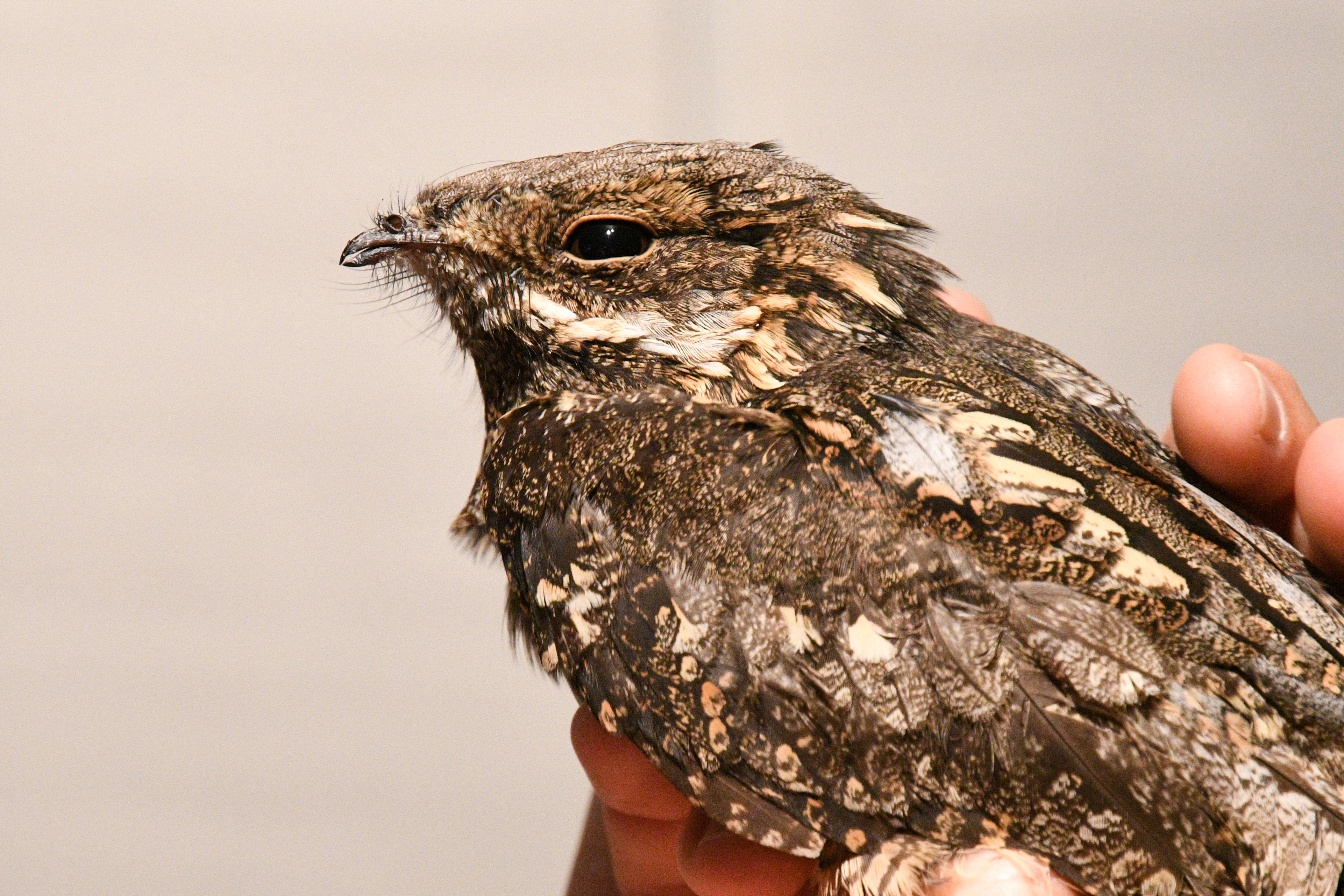
 Look at the fresh feathers of this juvenile Nightjar. (pictures: Simon Kiesé)
Look at the fresh feathers of this juvenile Nightjar. (pictures: Simon Kiesé)
Later that night we caught a second one, an adult male, which to our joy was already wearing a ring. This bird was ringed by us last summer about 10 kilometres away in the breeding area, as Simon (the first) was able to tell us directly. Exciting to see one of the birds again. Unfortunately, I didn't wake up for this bird, which is better, as we had to get up shortly after 3am the next morning to go to Skarvsøen for CES ringing.
So while Martina and I had our hands full with ringing Reed Warblers (Rørsanger), Reed Warblers (Rørsanger) and Reed Warblers (Rørsanger), Seán went to World's End to do a quick migration count. He then went back to rest up from the night he had spent doing the net checks for us.
Both he and we finally saw the young Goshawk (Duehøg) that has been flying around here for a few days. At home in Germany I see the species quite often, but now I am of course motivated to see as many species as possible here in Skagen.
At 1pm Seán was picked up by Knud to be taken to the station. Seán's time here is unfortunately over again. It was nice to meet you and I look forward to seeing you here again next May. Have a safe journey to Ireland via Aalborg and Amsterdam!
Also Tine and her family left this morning. They got the chance to see the nightjar last night as their good-bye present. Thank you for all the interest you showed in our work and for being such lovely guests!
After a necessary and well-deserved break, the two remaining volunteers got back to work. Martina cooked and I started writing this blog and vacuuming the floor. Then our two new guests also arrived at the flat. As the next days are full of wind and storm, we unfortunately can neither ring nor do the standard migration count. Yay, finally a good night's sleep. I had almost lost faith in being able to sleep in here ;-) But as soon as it's dry, I'll use every minute to go seawatching. Hopefully the wind will bring some great birds. When the wind dies down again, conditions will be good for catching Storm Petrels. It has to happen again sometime, doesn't it?
I hope you have better weather or use the weather to hope for some shearwaters!
Ringing (Skarvsøen )
Tornsanger (Common Whitethroat) - 2
Rørsanger (Reed Warbler) - 27
Gransanger (Chiffchaff) - 5
Blåmejse (Blue tit) - 1
Munk (Blackcap) - 3
Gærdesanger (Lesser Whiterhroat) - 4
Lille Gråsisken (cabaret) (Lesser Redpoll) - 1
Løvsanger (Willow Warbler) - 1
Total: 44
People: Seán Walsh, Martina Hillbrand, Simon Kiesé, Simon S. Christiansen, Lisa Vergin, Karen and Henrik Toft, Lise, Tine and Elinor
A link to today's observations from volunteers and local observers.
Simon's first whale
For the first time in a while, I did the morning migration count with Simon. I had spent the last week or so ringing with Martina where the weather allowed us as I entered my last week working at Skagen Fuglestation trying to learn as much as possible. In contrast to the last few days of migration, it was slightly better as the winds were a bit stronger. The morning started nicely, with some Mallemuk (Fulmar) and Lomvie (Guillemot) movement. Then, we began to see some skua movement at sea, even though there was none on the beach anymore. We saw four Storkjove (Great Skua) migrating north-west in total, and two Almindelig Kjove (Arctic Skua) also going north-west. As we neared the third hour of our count, the winds picked up even more and we saw many of the birds we had just counted coming back in the opposite direction. It was a sign to stop the migration count as not to risk double counting. The weather is a good omen, though, for our Stormsvale (Storm-petrel) catching tonight. If a bird as large and heavy as a Storkjove is driven back by the wind, then we are more likely to catch the small Stormsvale.
Simon was also incredibly happy today as he saw his first large whale while doing the morning migration count! Rolf and he belived it to be a Minke whale. We observed it jumping many times out of the water from World's End. There have been some sightings of Minke whale lately in Danish waters and particuarly on the Danish north coast so it being a Minke seems likely.
Martina was supposed to join us on the migration count, but she believed she had once again been fooled by the weather forecast. As Simon and I got ready to leave, she was getting ready to also, but instead to go ringing. She opened the nets at half 5 this morning thinking there might be something. She only ended up catching a Gransanger (Common Chiffchaff) and, rather nicely, a Havesanger (Garden Warbler).
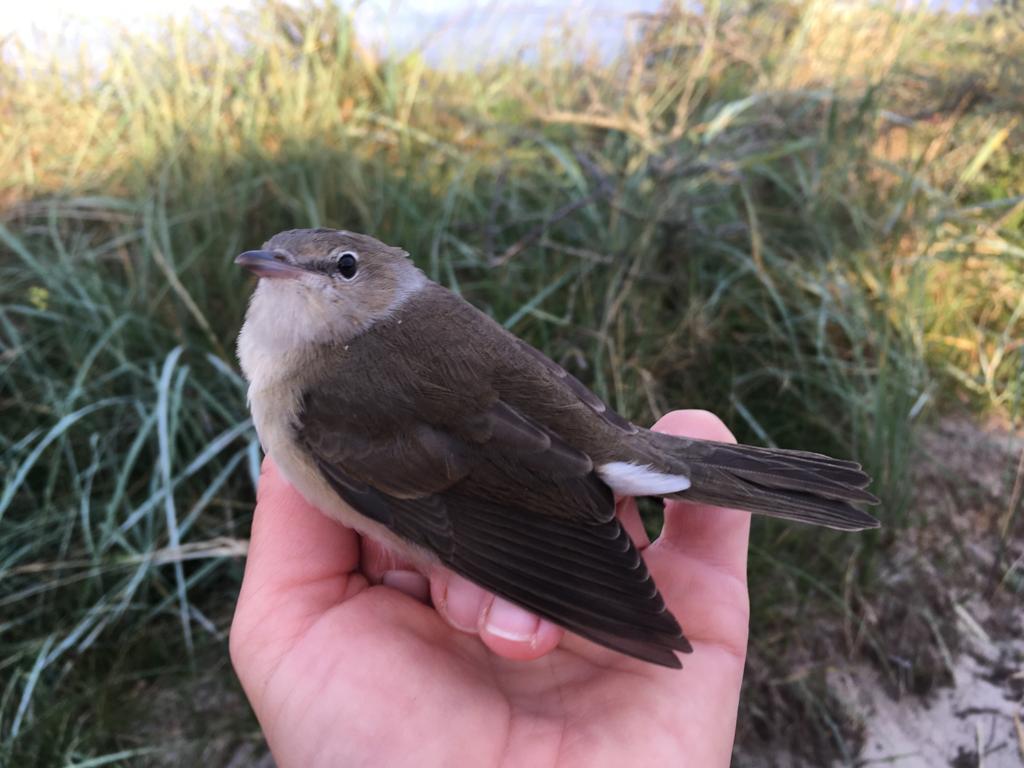
Today was my last full day here. I am a little sad I didn't get to spend it ringing at Kabeltromlen but I am confident that we will catch something nice tonight, even if its not a Stormsvale. I cooked a farewell dinner of sorts, chana dal, Martina's favourite meal. I attempted to make enough for leftovers, but it seems like it'll all be gone by tomorrow's dinnertime. I'm leaving tomorrow around lunchtime. The six weeks I have spent here have been amazing in many different ways. I have learned a new skill I have wanted to for years, I have seen many new and different birds compared to my home in Ireland. And I have met some really nice people from the beginning of my time here to the end. I look forward to seeing Simon Kiesé and Simon Christiansen again next May, when I return for the spring season, hopefully with more experience.
Tally ho.
Ringing (Kabeltromlekrattet)
Havesanger (Garden Warbler) - 1
Total: 1
Skagen People: Seán Walsh, Martina Hillbrand, Simon Kiesé, Simon S. Christiansen, Lisa Vergin, Lise, Tine and Elinor
A link to today's observations from volunteers and local observers.
A link to the results of the latest NocMig-Recordings on Trektellen.
Migration has started!
Migration has officially started now, seeing that at the ringing, for the first time, we had more migrating brids than local birds. Although that is a really good sign, it still was a very slow day for ringing at Kabeltromlem. The night should have been reasonably good for migration and strong winds and more rain are on their way. Birds can somehow detect when bad weather is coming, so they can get away from it in time. This means that there probably was quite a lot of migration going on tonight, only, apparently, birds did not have a reason to stop at our place, they just went straight south. Whatever happened to all the whitethroats (tornsanger) that were in the area just a few days ago, we can only guess. They may either have learned where the nets are, so they can avoid them now, moved somewhere else around the area (although there is still plenty of food for them here!), or they have already started migration as well, in face of the bad weather to come.
It was Sean’s last day at the ringing, since tomorrow it will be too windy. At least, he got to see some species that he hasn’t seen so often this year, like willow warbler (løvsanger) and marsh warbler (kærsanger). Also, in the closing round, we still caught a very young icterine warbler (gulbug), showing that they had been breeding locally. The parents were both around the net and calling loudly, while we extracted the bird. We made sure to ring it quickly and take it back to them. Despite the not fully grown wings, the bird was already very skilled in flying!
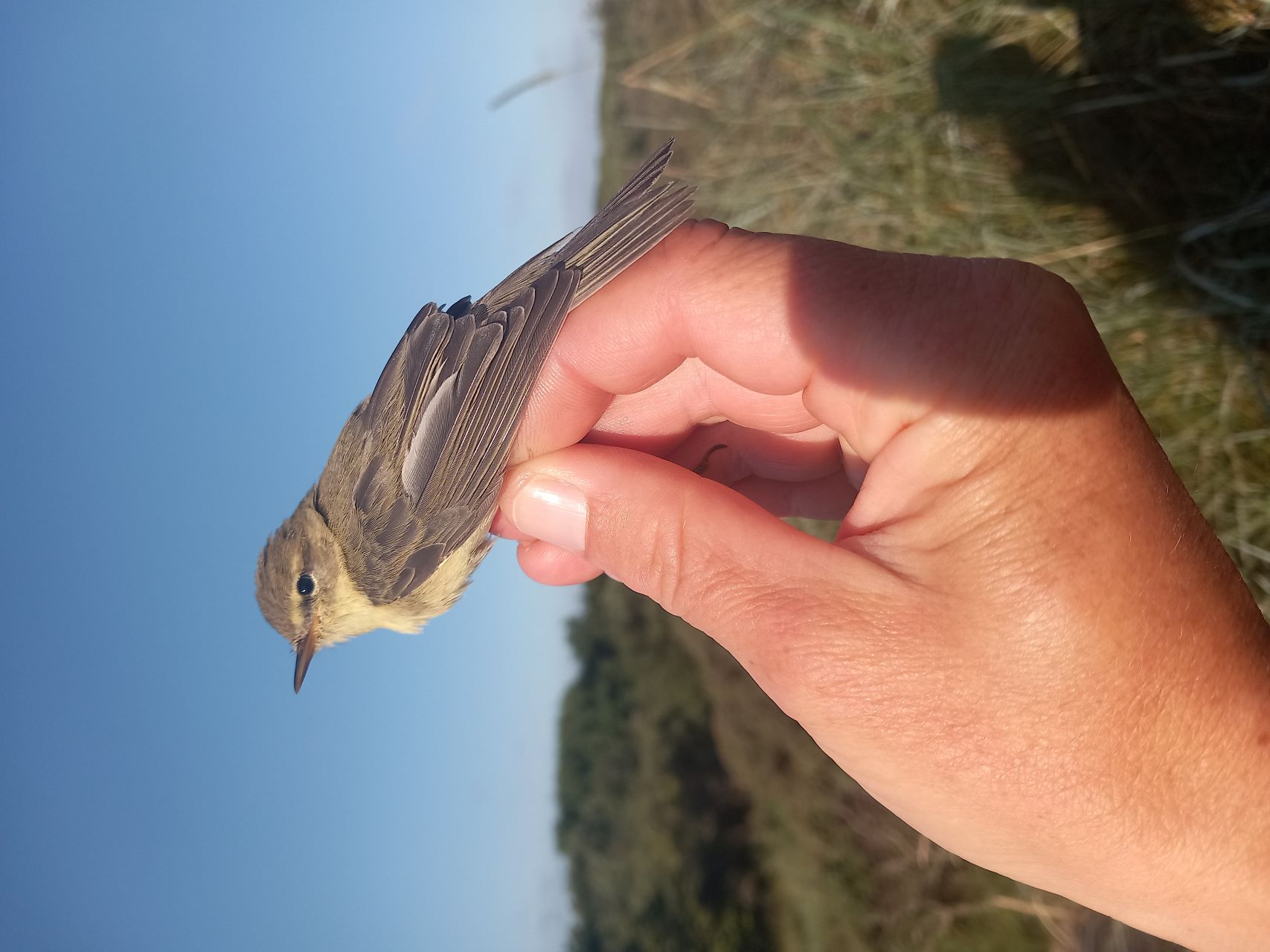
Picture of the first willow warbler (løvsanger) this morning - first sign of migration!
Simon junior, meanwhile, was out doing the seabird count at World’s End 3. Again, he had very good views of some fulmars (mallemuk), but not much else to speak of (quote: ”I was there for three hours and had absolutely no birds”, quote two seconds later: ”I counted about 300 gulls, a few fulmars, a black-throated and two red-throated divers, two razorbills…” [look for the complete list in Danish in the DOFbasen link below]). So, despite it being slow, there were some nice species to observe, just not lots of them.
In the email, on the other hand, we had some interesting news from a foreign ringed chaffinch we caught earlier this year: it was a female that was ringed in March, probably on her wintering grounds, in Southampton, England. A little more than a year later it was recovered at Kabeltromlen, on the 31st of May this year.
After the morning we all went home, and since yesterday was spent doing all the things, we didn’t have time to do before, there was not so much left to do today. We had a nap and then Sean cooked dinner for all of us and the guests from the apartment. Tine has gotten into birding very much, while her mother is enjoying the beach and the beautiful scenery, and her daughter is mainly just enjoying her last days of holidays before school starts again. She did come out with her mum to Kabeltromlen one last time to see the ringing today and quite enjoyed herself.
So this was it for “before the storm”. What happens after the storm, we don’t know, also it seems, a lot more storm is on the way. But for now, we hope that the wind will die down tomorrow evening, so we can catch storm petrels (stormsvale) again, hoping (or fearing) some have been blown our way.
Tomorrow morning should be interesting for sea watching so you will find us all out at World’s End. It will be too windy to set up nets for ringing in the morning.
Ringing (Kabeltromlekrattet)
Munk (Blackcap) - 1
Tornsanger (Common Whitethroat) - 2
Gærdesanger (Lesser Whitethroat) - 1
Kæersanger (Marsh Warbler) - 2
Gulbug (Icterine Warbler) - 1
Løvsanger (Willow Warbler) - 3
Gulspurv (Yellowhammer) - 1
Total: 11
People: Seán Walsh, Martina Hillbrand, Simon Kiesé, Simon S. Christiansen, Lisa Vergin, Lise, Tine and Elinor
A link to today's observations from volunteers and local observers.
A link to the results of the latest NocMig-Recordings on Trektellen.
Ringing at the lighthouse
Today, again, we were a little bit fooled by the weather forecast: I woke up at 3am to look at the forecast which promised rain half an hour later, so I decided to wait for an hour, before we open the nets. Then at 4 I woke up again, and the weather forecast said the same, although I am quite sure it hadn’t rained in the meanwhile. Seeing that there had been many rain clouds everywhere between us and any place birds could be coming from right now (Sweden and Norway mainly), I decided to not take the risk of having nets open in the rain and just leave the ringing for today. The local birds we can still catch another time and this night is a better night for migration, so tomorrow I am hoping for at least some migrating birds at Kabeltromlen. The problem with having the nets open when it is raining is, that birds caught in the net cannot use their plumage to stay dry, because some feathers might be pushed to the side by a string of the net, so that a part of their skin is exposed. So when it starts raining, we always have to close the nets and make sure we take the birds caught very quickly, before they get too cold. In case of doubt it’s always safer to just not open them. The safety of the birds being more important than any data that might be missed.
So, I went back to sleep for a little while, while Simon junior and Sean went to World’s End 3 to do a migration count. They managed to observe a group of 15 fulmars (mallemuk) closely, which was quite nice. Other than that, however, there was not so much to observe. Even the shorebirds that had been on the beach for the last few days, had left. Not a lot of terns or gulls either. Talking about gulls, there was a mystery gull on the beach, which was maybe a yellow-legged gull (middelhavssølmåge) herring gull ssp. omisus (sølvmåge ssp. omisus) the species still being debated. We would highly welcome good pictures of it if anybody observes it.
The rest of the day was spent doing miscellaneous tasks that we had not managed to do the last few days. Sean went to Skarvsøen and did the cormorant count, I went to Kabeltromlen to fix some ringing equipment and then to the beach to look for ringed gulls, and Simon did some computer work.
During all that time we had the nets in the lighthouse garden open in the hope of catching something. We did have luck with a great tit (musvit) early on. Then nothing for long hours. Then, when all of us just came back from our various works we met out in the lighthouse garden and chatted a little with a German bird watcher who had come by for a visit and for discussing the above mentioned gulls. While we were there, a tree sparrow (skovspurv) came to sit in one of the bushes, where also the yellowhammers (gulspurv) are now busy carrying food for their young. Simon really wanted to catch it, so he played the tree sparrow call with his phone from the other side of the net. The sparrow did not seem very impressed, but just as Simon gave up, sure enough, the sparrow flew right into the net towards the place where Simon had played the call before. So we got to ring that one as well – a bird we do not often catch around here.
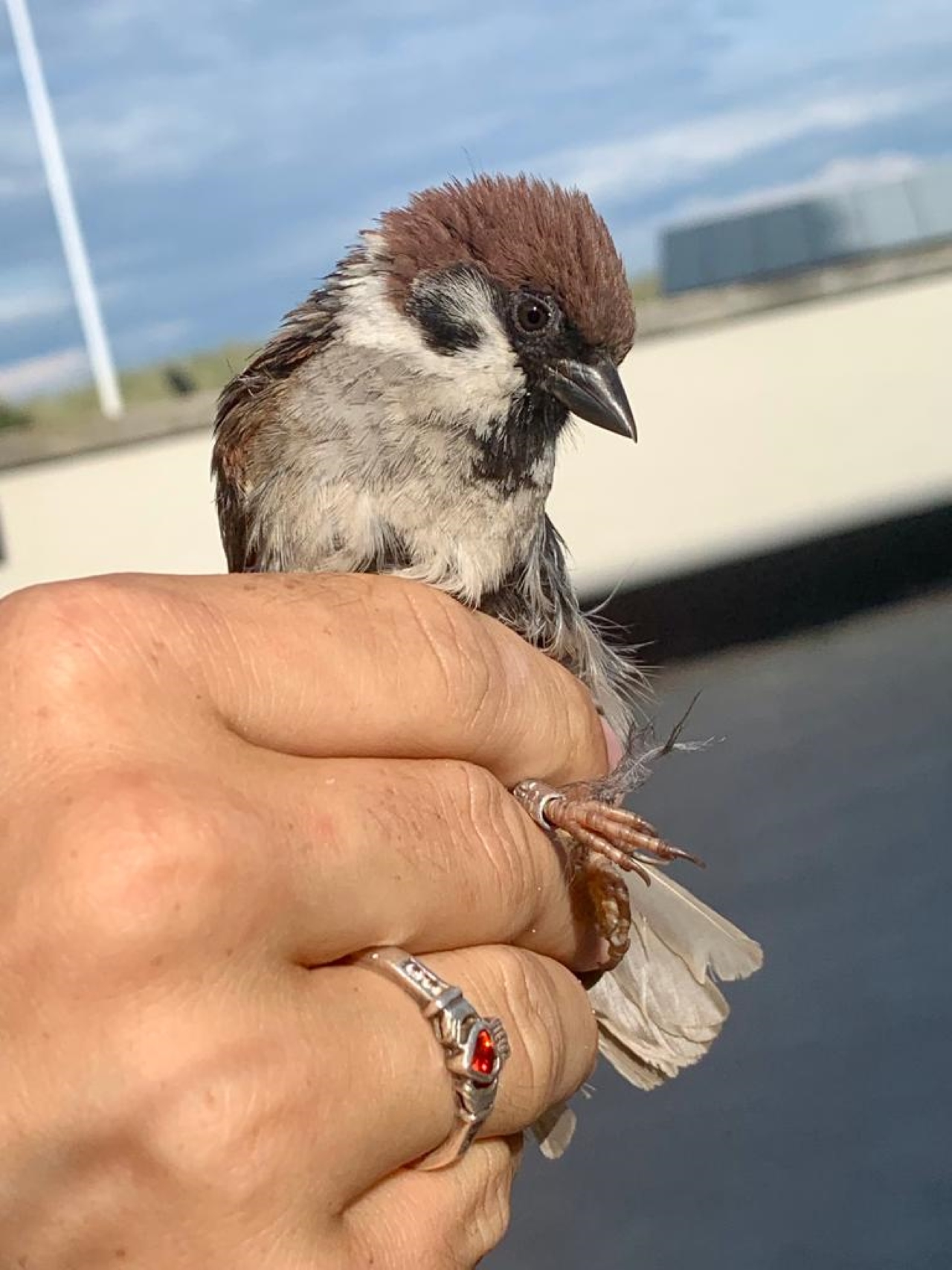
When entering the rings of the gulls I read at the beach, I found an old friend, that I have already read last year: JA688. The thing that is so cool about this bird is, that it has been ringed in 2008 as a chick in Norway, so it is 15 years old now! On the picture it is the ringed gull in the back, the one that is preening:

The next few days will be a little bit mixed, with various kinds of weather waiting for us: Tonight should be a good night for migration if the rain clouds over southern Sweden and Norway do dissolve like the weather forecast promises. So we hope for a good morning ringing tomorrow at Kabeltromlen. Then later tomorrow we expect quite strong winds coming from the west and we really do hope that they might bring some good sea birds with them, that we normally don’t get to observe close to the shore. So, Saturday will be observation day. And then Saturday night we will try to catch storm petrels again, hoping that some might have been blown our way with the strong winds. As usual, you are welcome to sit around Saturday night and wait if we get lucky.
Ringing Fyrhaven
Musvit (great tit) - 1
Skovspurv (tree sparrow) - 1
Total: 2
People: Seán Walsh, Martina Hillbrand, Simon Kiesé, Simon S. Christiansen, Lisa Vergin, Peter Kristensen, Lise, Tine and Elinor
A link to today's observations from volunteers and local observers.
A link to the results of the latest NocMig-Recordings on Trektellen.
Catch and Recatch
Last night we set up nets again. It didn't take long and when Seán checked the net for the first time, he could see a Nightjar (Natravn) flying around the net. Unfortunately it didn't fly into the net and flew off after a while. But when Seán went closer to the net, he saw that there was one hanging. For him and me, this was the first ringed Nightjar. What a cool bird! It was an adult female. It's totally exciting to see how the species is adapted to the darkness with its big eyes. The beak looks tiny, but when the nightjar opens it, it would fit a ping-pong ball. Perfect for catching all those pesky mosquitoes away.
 Nightjar (Natravn) - female ad. (pic: Simon Kiesé)
Nightjar (Natravn) - female ad. (pic: Simon Kiesé)
As today was a quiet migration day, there is not too much else to report. A pair (male and female) of Bullfinches (Dompap) made us very happy in Kabeltromlen.
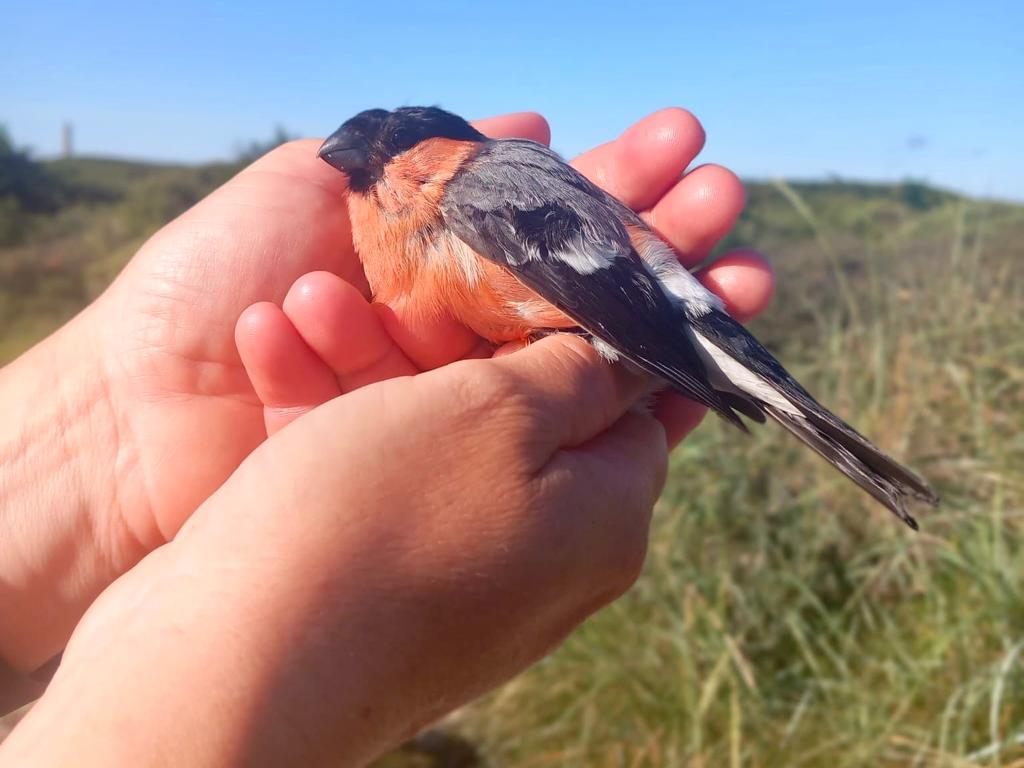
Bullfinch (Dompap) - male (pic: Seán Welsh)
In the morning, Hans guided a bird watching tour from the lighthouse to Grenen beach. Several interested tourists were joining him. Their first stop was at the ringing at Kabeltromlen, where they got to observe the ringing of a reed warbler (rørsanger) and a whitethroat (tornsanger). Then they walked on to the beach and got some introduction to identifying gulls (måge) and the few shorebirds (ryle) that are still left out there. They also observed the gannets (sule) diving for fish.
The highlight of the day was something else. When Simon (the 1st) told us that one of our Storm Petrels (Lille Stormsvale) had been recaptured, we could hardly believe our ears. The first bird we had ringed last week was recaptured only 48 later, 370km away as the crow flies. It weighed 2.7 grams less, which makes sense given the distance this little bird must have travelled. This is the first reading of a Storm Petrel ringed in Denmark. Brilliant! Simon has also written an article about it in which the story is explained with a few pictures, feel free to check it out: The article about the Storm Petrel recatch.
Ringing (Kabeltromlekrattet)
Gulbug (Icterine Warbler) - 2
Gærdesanger (Lesser Whitethroat) - 3
Rørsanger (Reed Warbler) - 1
Løvsanger (Willow Warbler) - 1
Munk (Blackcap) – 3
Tornsanger (Common Whitethroat) - 4
Dompap (Bullfinch) - 2
Gransanger (Chiffchaff) – 1
Total: 17
People: Seán Walsh, Martina Hillbrand, Simon Kiesé, Simon S. Christiansen, Lisa Vergin, Hans Christophersen, Peter Kristensen, Lise, Tine and Elinor
A link to today's observations from volunteers and local observers.
A link to the results of the latest NocMig-Recordings on Trektellen.
Why is it called ARCTIC Skua?
The day started quietly today as there was little bird migration despite the nice weather. Nevertheless, I lasted 3 hours at World’s End 3. Although there was hardly any migration, I was able to observe several cool birds. In the morning a Temminck's Sandpiper (Temmincksrylen) was sitting on the beach and later I could observe two Honey Buzzards (Hvepsevåge) and a Woodlark (Hedelærke). I also had really nice views on five Harbour Porpoises.
One of the few migrating birds was two Arctic Skuas (Almindelig Kjove) heading north. Isn't that the wrong direction? Shouldn't you fly south? Well, at least they live up to their name ARCTIC Skua. It really fits to them, because they migrate from their arctic breeding grounds to subarctic wintering grounds. Their second englisch name Parasitic Jaeger is good as well, because it describes its behavoiur of chasing gulls and terns to steal their food, but in this part of the world we use the common one "Arctic Skua". Or the danish one Almindelig Kjove (I'm stil learning the danish bird names but I make progress :-)).
I also filled the boredom by ageing the gannets hunting at sea. Unfortunately, I could also see one that had caught its beak in a plastic string about 3 metres long and was dragging it behind it in flight. Afterwards I walked to Martina and Seán, who had had the nets at Kabeltromlen open since 4:30am.
Even during ringing there was no sign of newly arrived birds today. In the morning Simon (the 1st) stopped by, then also our guests from the flat, to whom we were able to show some nice birds. All in all, it was a quiet morning. Nevertheless, we were very pleased wto catch a Crested Tit (Topmejse) and a Chaffinch (Bogfinke).
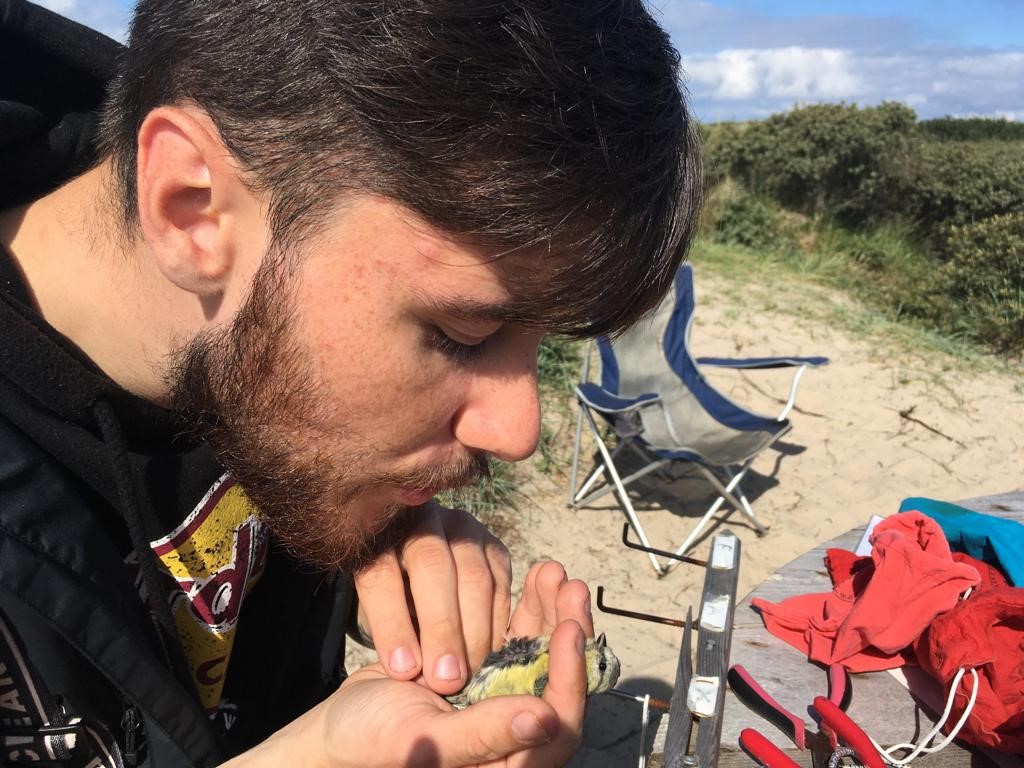 Seán checking the fat (condition) and moult of a young Blue tit (picture by Martina)
Seán checking the fat (condition) and moult of a young Blue tit (picture by Martina)
While Martina and Seán repaired and closed the nets, I walked back to the observatory and sat down to check the NocMig-recording There was not much bird migration during the night either, but I could identify a Curlew (Storspove), 2 Common Sandpipers (Mudderklire) and a Grey Heron (Fiskehejre) by their calls. You can see all the data under the link to Trektellen. After a short nap we held the evening meeting and are now preparing to hopefully catch waders tonight.
Ringing (Kabeltromlekrattet)
Tornsanger (Common Whitethroat) - 5
Gærdesmutte (Wren) - 1
Rørsanger (Reed Warbler) - 5
Gransanger (Chiffchaff) - 2
Musvit (Great Tit) – 7
Blåmejse (Blue tit) - 1
Topmejse (Crested Tit) - 1
Bogfinke (Chaffinch) - 1
Rørspruv (Reed Bunting) - 1
Total: 24
People: Seán Walsh, Martina Hillbrand, Simon Kiesé, Simon S. Christiansen, Lisa Vergin, Lise, Tine and Elinor
A link to today's observations from volunteers and local observers.
A link to the results of the latest NocMig-Recordings on Trektellen.
